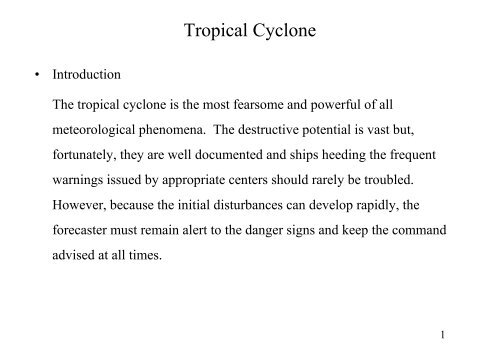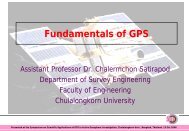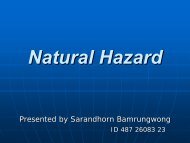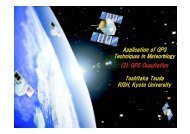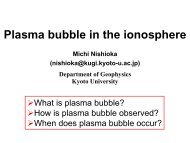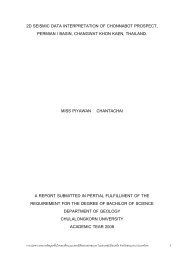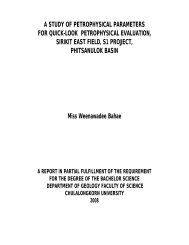Tropical Cyclone
Tropical Cyclone
Tropical Cyclone
- No tags were found...
You also want an ePaper? Increase the reach of your titles
YUMPU automatically turns print PDFs into web optimized ePapers that Google loves.
<strong>Tropical</strong> <strong>Cyclone</strong>• IntroductionThe tropical cyclone is the most fearsome and powerful of allmeteorological phenomena. The destructive potential is vast but,fortunately, they are well documented and ships heeding the frequentwarnings issued by appropriate centers should rarely be troubled.However, because the initial disturbances can develop rapidly, theforecaster must remain alert to the danger signs and keep the commandadvised at all times.1
<strong>Tropical</strong> <strong>Cyclone</strong>In the past tropical cyclones have been known by various general namessuch as ‘tropical revolving storms’, ‘severe cyclonic storms’ and ‘tropicalstorms’ the latter being in particular common usage today. However,because tropical storm is also a term used for a discrete stage in its lifecycle,the generic name tropical cyclone will be used exclusively in thishandout.• Classification<strong>Tropical</strong> cyclone are categorized by their intensity measured in terms ofthe highest sustained winds near their centers. The phrase ‘highestsustained winds’ equates to the mean maximum over a 10 minutes period2
<strong>Tropical</strong> <strong>Cyclone</strong>in the case of most Warning Centers, but American Centers use a oneminute period. As a general rule of thumb, reducing the American windby 10% will give a reasonable approximation of the 10 minute highestsustained wind.Although some warning centers use their own terminology, nomenclatureas laid down by the World Meteorological Organization (WMO) isfollowed by most3
<strong>Tropical</strong> <strong>Cyclone</strong>ab<strong>Tropical</strong> Depression (TD): Highest sustained winds of at least 22 knotsbut less than 34 knots (i.e. Beaufort force 6 or 7).<strong>Tropical</strong> Storm (TS0: Highest sustained winds from 34 to 63 knots.However, this category may be subdivided further.I. Moderate <strong>Tropical</strong> Storm: Highest sustained winds from 34 to 47knots ie. Beaufort force 8 of 9. Centers using this category may dropthe term ‘MODERATE’.II Severe <strong>Tropical</strong> Storm (STS): Highest sustained winds from 48 to 63knots i.e. Beaufort force 10 or 11.An American do not use this subdivision in the Pacific. I.e. their <strong>Tropical</strong> storm4
<strong>Tropical</strong> <strong>Cyclone</strong>• Formation RequirementsUnlike depression at higher latitude, tropical cyclone are warm corefeatures which depend on latent heat of condensation to fuel and5
<strong>Tropical</strong> <strong>Cyclone</strong>perpetuate their existence. They thus require the vast quantities of watervapor only found over warm tropical oceans and are unable to developoverland. The requirements for their formation may be summarized asfollows:a. A PRE-EXISTING LOW PRESSURE AREASince the minimum criteria for a tropical depression is 22 knots isfollows that a low born of some tropical disturbance must already bepresent. The disturbance may be found within the monsoon trough orassociated with tropical waves or TUTT vortices extending to the surface.Such disturbances are common place in summer but fortunately only about6
<strong>Tropical</strong> <strong>Cyclone</strong>10% are likely to develop into tropical cyclones.b. SEA SURFACE TEMPERATURE OF AT LEAST 26 o CThis provides sufficient water vapor to produce the warm core duringthe condensation process. The warmer the sea, the more conducive it is totropical cyclogenesis which helps explain why summer is the HurricaneSeason (along with the disturbances also prevalent at this time of year).Although empirical, the 26 o C value has proved so critical that evendeveloped tropical cyclones will weaken if they move over waters coolerthan this.7
<strong>Tropical</strong> <strong>Cyclone</strong>c. A MINIMUM VALUE OF LATITUDE OF 5 DEGREES<strong>Tropical</strong> cyclones require enough coriolis force to produce a cyclonicspiralling circulation. This means they cannot form equatorward of 5degrees and are rare equatorward of 8 degrees particularly in the Atlantic.So, even though a cyclonic disturbance with enhanced convective activitycan form close to the equator, it will not develop into a tropical cycloneunless it moves poleward to the required amount of latitude.d. UPPER LEVEL DIVERGENCEWithout outflow aloft the low level inflow would create a build up ofair resulting ultimately in rising pressure. Upper level divergence acts8
<strong>Tropical</strong> <strong>Cyclone</strong>rather like an extractor fan, removing the rising air from the top of thetropical cyclone ‘chimney’. A <strong>Tropical</strong> Depression or Storm passingunder a ridge of high pressure at the 200 hPa level will often develop toHurricane/Typhoon status.e. LITTLE OR NO VERTICAL WIND SHEARSignificant shear prohibits the formation of the warm core thuspreventing development. The critical value is thought to be about 20 knotsbetween 950 and 200 hPa level, wind shear would probably preventtropical cyclone formation I.e. deep easterly component winds extendingto at least 3000ft are necessary for development and such conditions only9
occur in the summer months.<strong>Tropical</strong> <strong>Cyclone</strong>• Life-cycleAssuming the requirements for formation are present, the life-cycle of atropical cyclone from the incipient disturbance to the dissipating phasemay be described in 4 stages:A) FORMATIVE This represents the transition from disturbance to<strong>Tropical</strong> Depression (TD). Surface pressure begins falling, thoughremaining above 1000 hPa and wind increase near the center. The10
<strong>Tropical</strong> <strong>Cyclone</strong>strongest winds are normally found on the poleward side between thecenter and the subtropical high, but they will still be less than gale forceduring this stage.B) INTENSIFICATION This is the period of major deepening to<strong>Tropical</strong> Storm (TS) or Hurricane strength with pressures rapidly fallingbelow 1000 hPa, possibly to as low as 900 hPa or even less. This stagemay take several days or occur explosively within 24 hours depending onthe conditions prevailing at the time. The tropical cyclone becomesclearly evident in its pressure and wind fields both horizontally andvertically and it is during this stage that the eye develops. The maximum11
<strong>Tropical</strong> <strong>Cyclone</strong>speed annulus actually shrinks during intensification and with large systemsthe ring of highest winds may contract from a diameter of hundreds of milesto 60 nm or less. However, the winds within this ring continue to increaseand the region of strong winds beyond also expands slowly during theintensification stage. Convective clouds increase in amount and verticalextent and form a band-like structure. Showers and squalls increase and rainbecomes widespread near the center.C) MATURE This stage is the period when the tropical cyclone remains ator near its maximum intensity although this may vary greatly from storm tostorm. Some mature as small intense systems while others develop12
<strong>Tropical</strong> <strong>Cyclone</strong>into the most powerful of typhoons or hurricanes. The mature stage canlast from a few hours to a week or more during which time the centralpressure remains roughly constant, although it may fluctuate in thepersistent storms if they interact with upper troughs extending into thetropics from higher latitudes.D) DECAYING The decaying stage represents the period when thesystem either loses its identity, or it assumes extra-tropical characteristics.<strong>Tropical</strong> cyclones moving inland will fill rapidly as their energy supply iscut off from below, particularly if the terrain is rough. Moving over seascolder than 26 deg C will also promote decay as will a low level feed of13
<strong>Tropical</strong> <strong>Cyclone</strong>cold air such as incursion of the winter monsoon from Asia into thesystem’s circulation (it should be noted, however, that cold bursts of polarair can have the reverse effect, creating intense cyclogenesis in stormswhich have become extra tropical). When tropical cyclones recurve intohigher latitudes they generally assume extratropical characteristics I.e.polar air is drawn into the system causing the ‘eye’ and tight band ofmaximum winds to become less defined.14
<strong>Tropical</strong> <strong>Cyclone</strong>• Structure and CharacteristicsFigure 1 shows a schematic cross-section of a mature tropical cyclone.The right hand side shows the convective increasing towards the centerbecoming most marked at what is termed the ‘eye wall’. The left handside depicts the common occurrence where convective is also concentratedin a weather band some distance from the wall with an interruption ofactivity between the two, often called the ‘annular zone’. The ‘inflowlayer’ comprises the bottom 3km of the storm, most of the inflowoccurring below one km. Outflow occurs at the top of the storm withsubsidence at the outer limit and in the annular zone. The ‘outflow layer’15
<strong>Tropical</strong> <strong>Cyclone</strong>extends from about 8km to the top of the storms occurring near 12km.Some descent also takes place within the eye, helping to maintain theraised temperature in the mid-tropospheric levels and causing it to berelatively cloud free.• Surface PressureMature storms have very low center pressures dropping below 900 hPa attimes although 920 to 930 hPa are more typical and some quite intensehurricanes may have center pressures around 950 hPa. A barograph traceof a tropical cyclone passing close to the observation point it shown at16
<strong>Tropical</strong> <strong>Cyclone</strong>17
<strong>Tropical</strong> <strong>Cyclone</strong>18
<strong>Tropical</strong> <strong>Cyclone</strong>• Cloud and PrecipitationThe basic structure has already been seen in Figure 1. Because of thesubsidence at the periphery the precursor of the close approach of thetropical cyclone is unusually warm and fine weather. The first cloud signswould be thin cirrus gradually thickening and lowering until the bands ofcumulus cloud become evident. These too increase in vertical extent asthe system draws nearer. The eye wall represents the densest cloud withtops extending to 15km or more is accompanied by very heavyprecipitation and rapid pressure fall. The eye is often cloud free apart fromsome patchy low stratus and perhaps some upper cloud.19
<strong>Tropical</strong> <strong>Cyclone</strong>The intense precipitation in the wall and outer bands of cloud (sometimescalled feeder bands) greatly reduce visibility and lower cloud basealthough the hurricane force winds reduce the visibility even more fromblowing spray. The banded structure shows well on radar. To observesuch a structure, radar wavelengths need to be of the order of 100 meters.Lesser wavelengths would be severely attenuated and the old fashioned3cm weather radar would probably not penetrate the first band withsufficient energy to produce detectable returns from subsequent bands.At sea, wind and sea states are the prime hazards, but inland and at coastalstations the main killers are landslips and flooding due to excessive20
<strong>Tropical</strong> <strong>Cyclone</strong>precipitation and abnormal rises in sea-level. The accumulated rainfallfrom the passage of a tropical cyclone can be staggering. As much as4000 mm (100 inches) has fallen from a single typhoon in the Philippinesand amounts of more that 250 mm (10 inches) over a 12 hour period at asingle station are not uncommon. Intense rain bands may supply over 100mm(4 inches) in one hour. To put these figures in perspective London’saverage annual rainfall is about 600 mm (24 inches).21
<strong>Tropical</strong> <strong>Cyclone</strong>• Sea and SwellDespite limited fetches in the maximum wind zones, the very high speedsstill manage to produce phenomenal wave heights in excess of 15m,particularly in the right hand semicircle (NH) where winds are strongest.Constructive interference may even produce the odd wave in excess of30m. Obviously such seas can inflict severe damage and are capable ofcasizing ships even of frigate or destroyer size. In fact, it is thought thattyphoons inflicted more damage to the US Pacific Fleet during WW2 thanthe entire Japanese Navy. One particular typhoon, encountered by the US3rd Fleet, caused 3 destroyers to be capsized and lost, 146 aircraft blown22
<strong>Tropical</strong> <strong>Cyclone</strong>overboard or damaged beyond repair, 13 other vessels requiring and 9others minor repairs.At low latitudes tropical cyclones move at speeds of the order of 10 knotsor less. If follows, therefore, that waves will move out of the storm area asswell ahead of the system. The waves propagate radially outwards asshown in Fugure 4 with the largest ones, generated in the right rarequadrant, moving out almost parallel with the storm track. Thus, swell isoften a forerunner of the tropical cyclone.For coastal stations there is the additional hazard of storm surges,sometimes called hurricane tides. As the tropical cyclone approaches the23
<strong>Tropical</strong> <strong>Cyclone</strong>land, the winds in the right hand semicircle (NH) will pile up water alongthe coastline to the right of the storm track. If this occurs at the top of thenormal astronomical tide, abnormal rises in the sea level will occur,particularly if the water is piling up in narrowing inlets. The resultingflooding in low lying areas can be catastrophic. In one particularlytyphoon in Hong Kong in 1937, 11000 people were killed, largely bydrowning in such as a surge situation.24
<strong>Tropical</strong> <strong>Cyclone</strong>• MovementAs a broad generalization, tropical cyclones form on the equatorward sideof the sub-tropical highs and then move in the anticyclonic flow. Theythus move westward in the easterly stages, normally at about 10 knots.Depending on the configuration of the high the tropical cyclone maycontinue is westward movement, usually with a poleward component, orrecurve round its western periphery. Figure 5 shows generalised meantrack around the world but it must be emphasized that individual trackscan be highly erratic.25
<strong>Tropical</strong> <strong>Cyclone</strong>26
<strong>Tropical</strong> <strong>Cyclone</strong>The strength of the steering currents depends on the intensity of the subtropicalhigh. When these currents are very weak the tropical cyclonesbecome slow moving or almost stationary. In this event there is a tendency,due to the tropical cyclones own internal forces, for a poleward drift.The presence of another tropical cyclone within about 800 nm can createinteraction between the two where they dumb-bell around each othercyclonically. This is known as the ‘Fujiwhara Effect’ in the Pacific wherethe higher occurrence of tropical cyclones makes such interaction a notunusual happening. The interaction is complex and its extent is dependenton the strength of the steering currents so it is not really feasible for the27
<strong>Tropical</strong> <strong>Cyclone</strong>ship borne forecaster to make accurate allowances for it.As previously stated, tropical cyclones generally move at around 10 knotsin the early stages but during intensification they slow down particularly ifthe deepening is rapid. Recurving storms also slow down during the actualrecurvature process but then speed up again as they engage the higherlatitude westerlies and have been known to move eastward at speeds up to40 knots as they become extra-tropical.28
very useful instrument is meteorological radar, and one hasjust been mounted on a satellite as part of the <strong>Tropical</strong>Rainfall Measurement Mission (TRMM). This transmitspulses of microwave radiation that is then backscattered byprecipitation in the atmosphere, yielding estimates of thedistribution of precipitation in three dimensions. Since thefall speed of precipitation is a function of the size of thedrops, and the reflectivity is sensitive to the size, an estimateof the precipitation rate can also be made. The very firstimage transmitted back to earth from the TRMM satellitecaptured a South Pacific tropical cyclone, as shown in Figure1.10. The cross-section shows the radar reflectivity, ameasure of the precipitation content.http://wind.mit.edu/~emanuel/geosys/node1.html29
http://web1.meso.com/wind-personal/glenn/171/lab12/lab12-hurricane/sld013.htm30
Hurricane Adrewhttp://www.csulb.edu/~rodrigue/geog140/lectures/storms.html31
<strong>Tropical</strong> <strong>Cyclone</strong>32
<strong>Tropical</strong> <strong>Cyclone</strong>33


